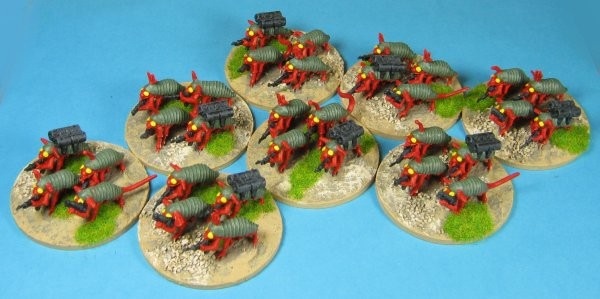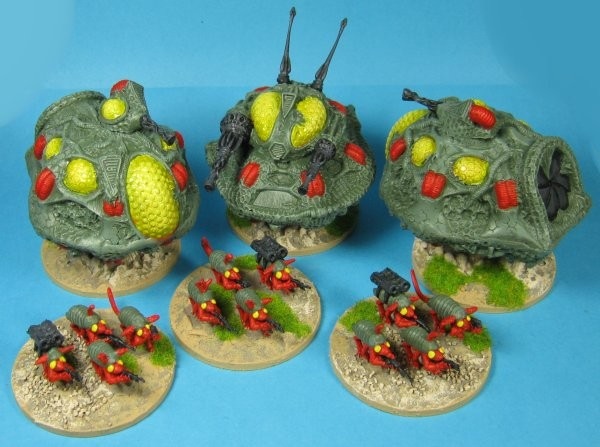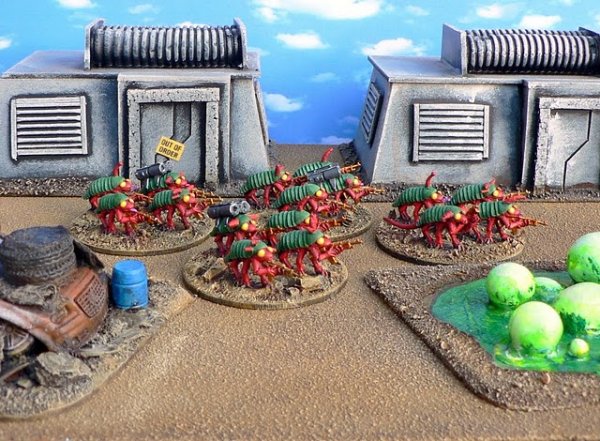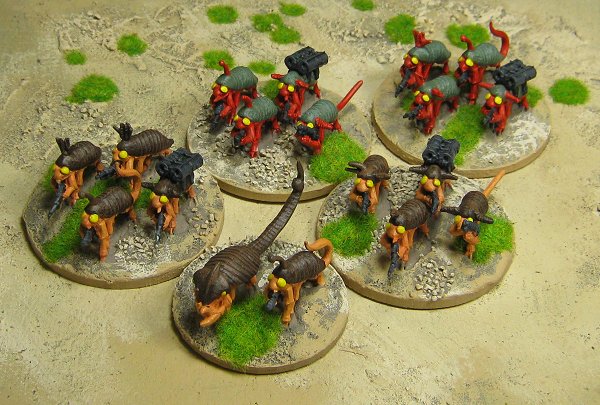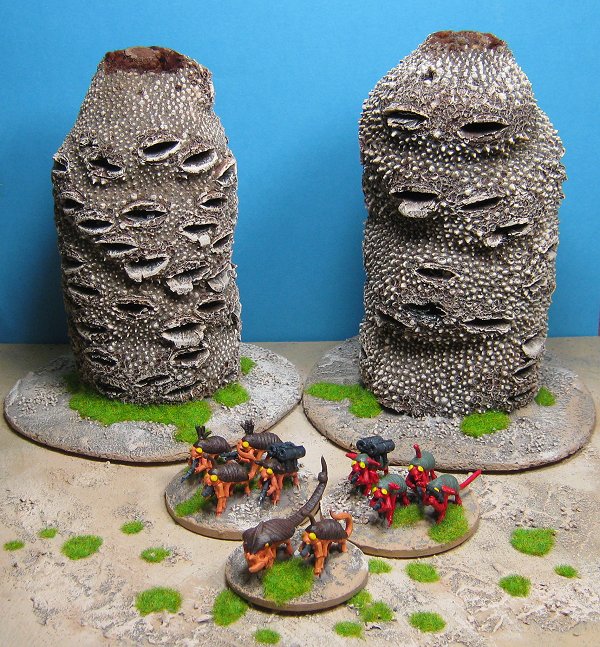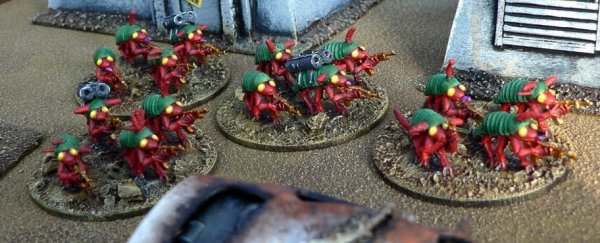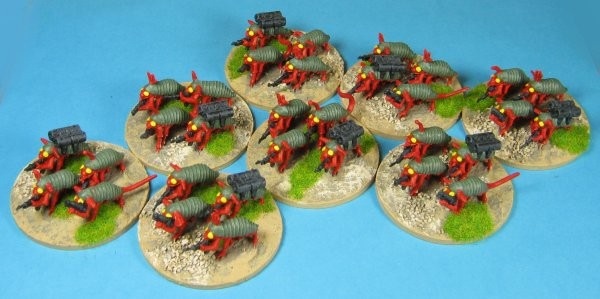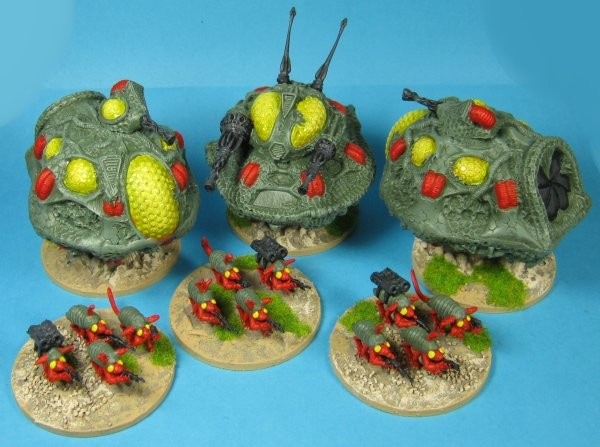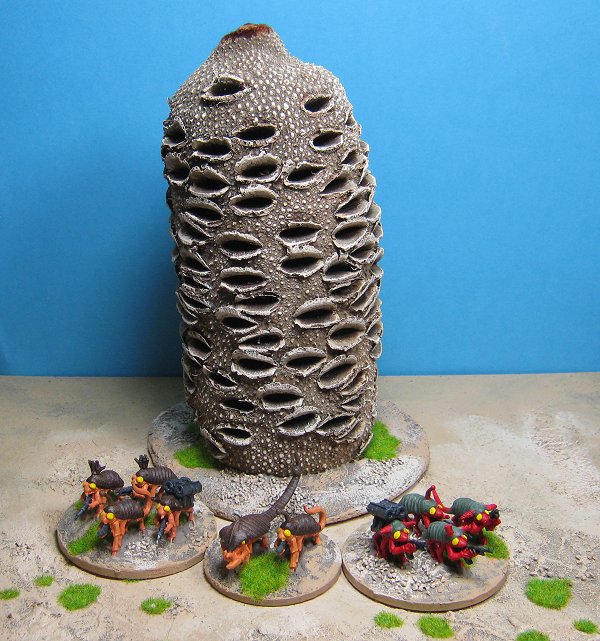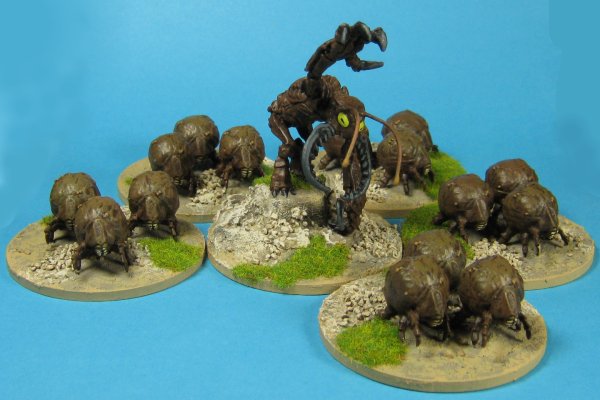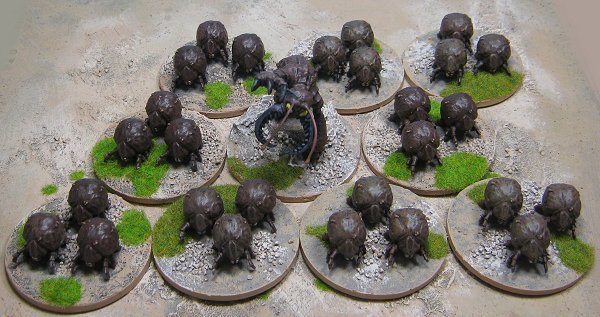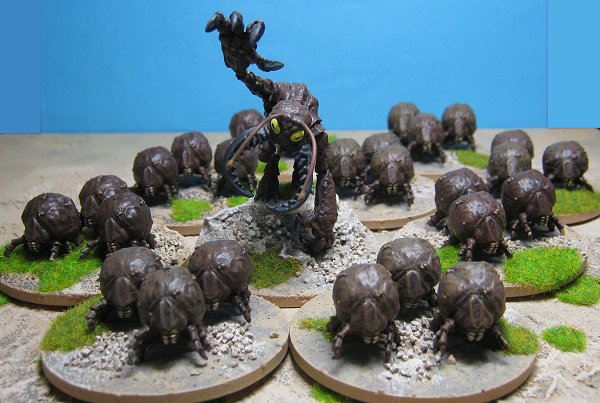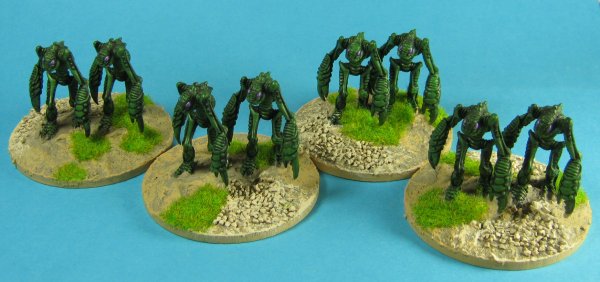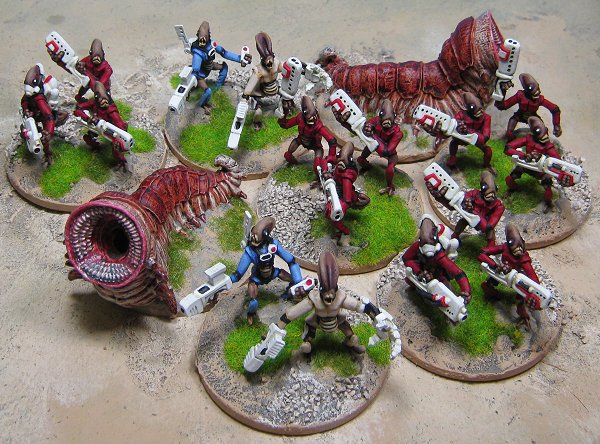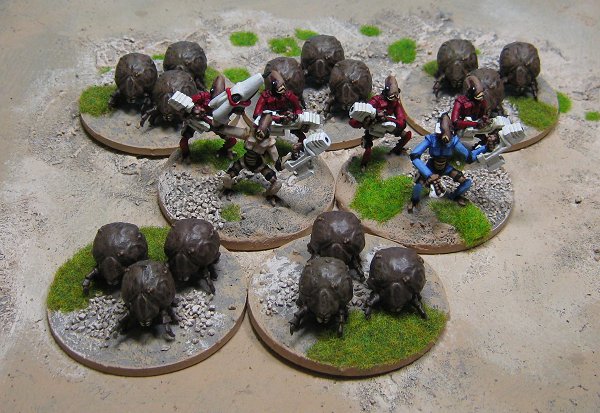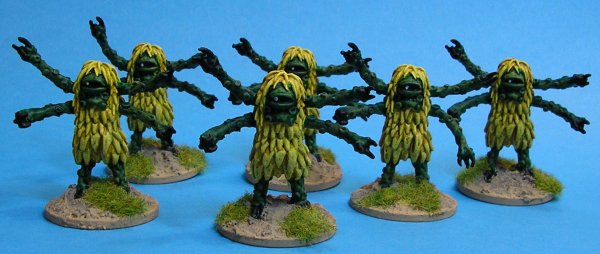|
The first element of the insect menace are Spice Lice from Irregular Miniatures.
They have armour support from Scotia Grendel.
I ruthlessly stole the idea and colour scheme for my Spice Lice army from Thorbjørn Nielsen who foolishly posted his on the Lead Adventure forum where I could see them.
“... a whole planet...made of cinnamon.”
The Spice Lice live beneath a barren, dusty, red planet that orbits close to a dying star. They are adapted to existing in darkness and inhabit huge underground colonies whose only outward signs of existence are the massive air ducts that extend above ground like termite mounds,often for nearly a mile into the atmosphere so they can access the dust-free airflow from high up. Spice Lice were given their name by humans because of their, and their planet's, distinctive cinnamon like smell. Their presence in an area is easy to detect because of this. Spice Lice are a practical rather than a warlike race and are often encountered as foraging parties out scavenging for resources that may be scarce or unknown on their home world. Unfortunately they find it hard to communicate with other races as their language is formed of complex chemical signals exchanged through the air or by touch and early contacts often degenerated into conflicts. Consequently the Spice Lice travel everywhere well armed and, since they have a schedule to keep to, often choose to eliminate obstructing life forms rather than attempt a usually fruitless communication. Organisation
Spice Lice can communicate quickly, freely and silently over the short distances represented by the table top but have no long range contact with their base so are unable to call up off board support such as artillery or air strikes. Their units are fluid and made up of varying numbers of 'cells' as the situation demands. Each cell is represented by a base of troops, it has four shooting dice and has a heavy weapon capability to attack and damage vehicles. Leaders are integral to the cells and are not represented by separate figures. Spice Lice may travel in anti-gravity armoured personnel carriers. Each vehicle model may deploy up to four cells of infantry. These vehicles find difficult terrain hard to negotiate and must check for bogging down if their move ends in a terrain feature that contains any form of tall vegetation or other vertical obstruction such as trees, bushes, buildings etc. the scenario should detail before hand which features will cause such difficulties. A Spice Lice vehicle does not have to check for bogging down if it merely passes through a terrain piece as part of an extended move sequence, in this case it is assumed to modify its travel height to compensate (it flies over the obstructions). Deployment
Because of their distinctive smell Spice Lice may not deploy hidden or conduct ambushes (unless their opponent has no sense of smell). If a scenario requires hidden placement each terrain piece that holds one or more Spice Lice stands must be denoted by a marker. The exact details and numbers of the Spice Lice present does not have to be revealed of course. Shooting
Usually cells will deploy in pairs to give a basic fire and manoeuvre capability but Spice Lice can utilise a combined crossfire ability where every cell or vehicle that can see a target may combine fire. All Spice Lice vehicles have indirect fire capability and a single APC that is unable to directly see a target may also be combined in each crossfire with other units. Indirect tank fire not be combined in this way, just APCs. APC have 4 shooting dice (a machine gun). Tanks have 5 shooting dice. Indirect tank fire has a 2 squad kill potential (treat as 120mm mortar). All vehicles may fire smoke (3 bases) and any other unit may act as their spotter. Smoke arrives on target with a roll of 3-6. Failure does not cause a loss of initiative. Typically vehicles will be able to fire 2 smoke rounds per game. Close combat
Spice Lice fight with little regard for personal safety, once they get to you you are in trouble. The chemicals they give off when communicating are irritants to many other life forms (much like tear gas) and getting close to them can be uncomfortable. Spice Lice units receive +2 for close combat and +2 for each additional stand including vehicles. When closing to combat Spice Lice ignore any pinned results from reactive fire. Morale
Spice Lice recover from a pin on 2-6 (they're not really bothered) and a suppress on 3-6. no other modifiers apply other than the +1 if no enemy in LOS. I made the Spice Lice towers from banksia nuts with one of the rounded ends sawn off so they could be stuck on to a base. I bought them for about £5.00 each off Ebay.
|
These are a more low tech menace. The grubs are from Heresy, the Umber Hulk (I added some antennae) is an old D&D metal figure.
Heresy had a recent promotion on their mites so I bought another dozen to add to my horde.
Also low tech are these Dreamblade figures who will get something to command them at some point. I like the regimented and purposeful look of these miniatures.
Alien Invasion Rules for Spugs
Spugs operate in squads of varying sizes, usually with Mites and/or Burrower Worms attached. Spugs are very quick and move 16 inches as an action. Spugs can also jump vertically up to 8 inches as a move (there must be a platform to land on). Mites move 24 inches over any surface including vertical ones. Burrowers cannot move on the surface. Spugs and Mites are unaffected by terrain except soft going like water or marsh which they can’t cross at all unless the Spugs can jump it, ie it is less than 8 inches across. Spugs roll 1D6 per weapon and can link fire. Heavy weapon rolls 4D6 Mites roll 2D6 in close combat only but may be exploded by their Controller as an action for a 6 inch radius blast effect of 4D6, any other mites caught in an explosion will blow up also and this damage will be linked to the previous damage. If the controller is killed the mites can do nothing except charge towards the nearest enemy (regardless of LOS) and attempt to melee them. Each time a Triple Action card is drawn for the Spugs, one action MUST be used to move uncontrolled Mites if there are any. They can be moved with actions as normal too of course. A Controller can direct the mites to a target he can see without having to see their path to it so the mites can be sent on flanking moves etc. Spugs are tough and require the following scores to kill: Open- 9, Cover- 12, Building- 15. Mites require the same as humans: Open- 6, Cover- 9, Building- 12. Mites do not explode when shot or killed, they must be detonated by a Controller. Burrowers are armoured and require 30 in order to kill them regardless of terrain. Burrowers spend 1 action to tunnel down, 1 to tunnel anywhere on the table and 1 to surface. Accompanying Spug squads are carried down and along for free but require an action to deploy on the surface. Burrowers may be moved independently to rendezvous with their squad if it has moved away. Place a Spug hole at burrow points. Surfacing at an existing Spug hole does not require an action for the Worm but still requires a deployment action for the accompanying Spugs. Burrowing down always requires an action. Spugs do not fall back after close combat, they fight to the death. Combat with Spugs that does not result in their extinction will be continued and resolved on the next appropriate card draw. An opponent of the Spugs may take an action with a whole group to close a hole. Spugs should start with a total of three holes per squad, 2 per squad deployed and the rest to build as needed. Burrowers can attack in melee if they appear next to a group of enemies. They roll 6D6. Additional Rules. Humans (and others) in the sewers. If you want to let humans and other non-burrowing races move underground then they can do so by by descending (1 Action) Moving (1 Action) and surfacing (2 Actions)- this keeps them from scooting round the board because they'll have to wait to get back up again, it also makes it dangerous, - Every time theres a Special Event card drawn underground groups meet in a sudden melee, resolved there and then. After the melee, losers surface at a point of their choosing. Unlike in a normal melee, underground dwelling factions like Spugs will attack first and resolve their damage before any other factions get to roll their attacks. You will need either a sewer system denoted by manhole covers on the board or a Spug tunnel system for this option. The Cyclopians are a mysterious race from a far distant world. Each group of Cyclopians are in fact a single creature with multiple bodies. Long ago, all female Cyclopians seemed to decide that the males were too hideous to have sex with and refused.
Since then the virtually immortal and very frustrated male Cyclopians have been searching the galaxy for suitable partners. Sometime around 1955 a male Cyclopian reached Earth and found out how wonderful the females of this planet are. Since then planet Earth has been like a magnet, attracting rogue male Cyclopians from all over. Luckily for us, there are great distances involved and so Cyclopian visits have been comparatively rare. Cyclopians are only interested in mating. They will mate with anything to see if it’s compatible. They get very angry and frustrated when they find that something isn’t compatible and tend to lash out; well, wouldn’t you? Cyclopians only attack in close combat, most of the initial damage is caused by the abortive mating attempt and subsequent attacks are due to anger and frustration. Falling to the first attack of a Cyclopian is not a pleasant way to go. Cyclopians inflict 4D6 damage in close combat. They get to attack once for every action they spend, the same as if they were locked in close combat and shooting before the combat is resolved. When a Double or Triple Action card is drawn and the close combat is resolved they will get their usual 4D6 close combat attack as normal. The lifeforce of the Cyclopians resides in only one of the bodies, the rest act as automatons. Only the body containing the lifeforce is susceptible to damage, all the other bodies just regenerate. The lifeforce body regenerates too but the shock of taking the damage is what kills the Cyclopian. As the body containing the lifeforce is killed the Cyclopian will transfer its consciousness to one of the other bodies and this will, in turn, become vulnerable. This means that the Cyclopians need to be killed in the right order to actually get rid of them. It takes 20 points of damage to kill a Cyclopian with the lifeforce in it regardless of cover bonuses. Before the game starts the Cyclopian player will arrange his Body Cards in any order he likes and this will be the path that the Cyclopian lifeforce takes through the bodies as the game progresses. No other player may look at these cards during play. A Cyclopian will start the game with three bodies plus one for each other faction. So, in a four player game the Cyclopian player would start with six Cyclopians. Cyclopians operate as single figures and may not combine into larger groups. The Cyclopians win if they manage to mate with one female for each body they began the game with. The total number of matings is what counts, not which body does them and any female will do, human, livestock, alien whatever. Mating is an action. Unfortunately the act of mating with a Cyclopian is fatal to most other creatures who suffer the 4D6 damage. If the subject survives the Cyclopian can try and mate with it again, easy points! The Cyclopians are after sex, and lots of it. Every time a Cyclopian successfully mates the Cyclopian player should make a note or get a token or something to keep score. Writing the names of the victims in a little black book is an acceptable way of keeping score. The Cyclopians were inspired by yet another wonderful model from the Wargames Supply Dump. |


